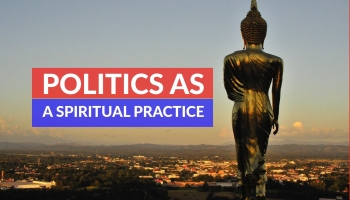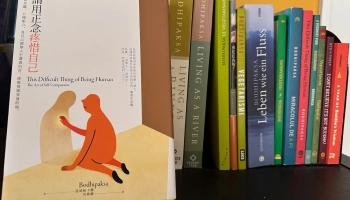

This is an extract from the introduction to my current course on Mudita, which is part of a longer series of teachings on the brahma-viharas — also known as the “immeasurables.”
The third of the Brahmaviharas, after lovingkindness and compassion, is mudita. Mudita is usually translated as sympathetic or empathetic joy, and is described as “feeling happy because others are happy.”
This is an interpretation I profoundly disagree with.
A first century text called the Path to Freedom describes the cultivation of mudita like this:
When one sees or hears that some person’s qualities are esteemed by others, and that he is at peace and is joyful, one thinks thus: “Sadhu! Sadhu! May he continue joyful for a long time!”
(Sādhu, by the way, means something like “Yay!” or “Alright!” or “Great!”)
The records we have of the Buddha’s teachings don’t define mudita, and the text above is the earliest I know of that gives us an indication of what mudita is and how it’s to be cultivated. There are several things that are significant here.
- We’re asked to call to mind someone whose skillful qualities are developed to the point where others esteem them. Having mudita involves recognizing what’s skillful.
- We’re not just being asked to call to mind someone who is happy, but someone who is happy (and at peace) as a result of having those skillful qualities. So when we have mudita we see the connection between skillful actions and their beneficial results.
- Appreciation is involved. We appreciate skillful qualities, and the peace and joy they bring, as being good things.
- Love is involved. Because we want what is good for them, we encourage this person’s future joy and happiness, by supporting, rejoicing in, and encouraging their skillfulness.
- By valuing this other person’s skillfulness, and the peace and joy that come from it, we ourselves become joyful. So we’re cultivating a state of appreciation that’s joyful.
This all goes far, far beyond “being happy because someone is happy.” That much more mundane experience is actually fraught with spiritual difficulties, because a lot of the apparent happiness we see around us arises on the basis of unskillful actions. We shouldn’t be glad that someone is happy because they’ve just defrauded an old lady of her life savings, for example.
In summary, when we practice mudita we appreciate skillful attributes, speech, and actions, and this brings joy. And so mudita is “joyful appreciation.”
A Progression
There is a progression in the first three brahma-viharas.
Metta is kindness. We want what is best for others’ long-term happiness and well-being. We want them to be happy. We want them to feel supported and to know that they matter. We speak and act kindly, and think about others kindly as well.
Karuna, or compassion, is what happens when we want beings to be happy but are aware that they are suffering. In order for them to be happy we want to remove their suffering, or at least support them while the suffering persists.
When we have mudita we want others to be happy, but now we recognize that happiness is not something that happens randomly. The happiness we’re interested in is the kind that comes from having skillful qualities. And so, wanting beings to be happy, we recognize the skillful qualities within them that give rise to happiness, and we appreciate, rejoice in, and encourage the development of those qualities.
To have mudita we have to be able to recognize conditionality, which is the way in which certain conditions and actions give rise to suffering, while others free us from suffering. Mudita is therefore at least in part a wisdom practice.
Just as we can define compassion as metta meeting suffering, we can define mudita as metta meeting skillfulness. This meeting is a joyful experience, or at least is capable of arousing joy.
The Stages of the Mudita Practice
As with the lovingkindness and compassion practices, there are five stages in joyful appreciation meditation.
- We start with cultivating appreciation of ourselves, or at least establish kindness towards ourselves. This stage is not found in the earliest description of the practice, but is a healthy place to begin, given that many of us often lack appreciation of our own skillful qualities.
- We then call to mind a person who embodies skillful qualities and experiences peace and joy as a result.
- Then we do this for a relative stranger (“neutral person”).
- Then for person we have difficulty with.
- And then finally we wish that all beings develop skillful qualities and experience calm and joy as a result.
As with the compassion practice, there is no “friend” stage. The person with skillful qualities in the second stage may be a friend, or we can include friends in the final stage.
For the first few days, we’re going to focus on self-appreciation.
Today I’ve chosen an exercise from “Living With Appreciation.” It’s on “Taking time to savor the positive..” The guidance begins with a short talk and is 10 minutes long in total.
Meditation Isn’t Enough
Although mudita bhavana is a meditation practice, developing joyful appreciation is something we can and should do in daily life as well. We can recognize skillful words and actions that we encounter, and we can also be more generally appreciative — recognizing and being glad for anything whatsoever that bring benefits to us or others.
An Exercise
Today, carry around an attitude of appreciation as best you can. As you encounter others, or even just think of them, be aware that they contain the seeds of goodness. When good things happen to you, however minor they seem dwell on them appreciatively.

Wildmind is a Community-Supported Meditation Initiative. Click here to find out about the many benefits of being a sponsor.








